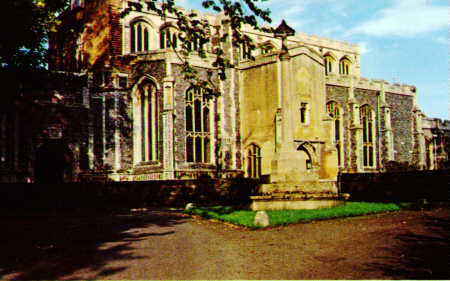

On the South face beautiful East Anglian flintwork, with grades of workmanship from the earliest irregular stones to the squared flints in regular courses (packed with flint chips called "gallitting") round the tower base.
Begun in 1525, by tradition at the expense of Cardinal Wolsey, whose death in 1530 stopped the work through lack of funds.
Initial letters of Latin words: in English, For Holy Church lohn Fine, Francis (or Frederick) Yual and others made (this gift) in honour of Jesus and Mary. South Porch Priest's room above, subject of a famous painting by John Constable, R.A. The pillars supporting the seats almost certainly came from an earlier (]4th C?) building.
Bears a star or "mullet", emblem of the De Veres, Earls of Oxford, sometime lords of the principal manor and the then patrons of the living.
Built in 1531 to house the bells, one of which is dated 1450: unique in that the bells are rung, not by a rope and wheel, but by force of hand on the wooden headstocks.
The Constable family tomb - last used in 1949 - is in the North East corner of the churchyard near the Boiler House. The artist's parents are here but Constable himself is buried in Hampstead cemetery in London. The grave of William Lott (of 'Willie Lotts Cottage') is located by the main path adjacent to the East end of the Lady Chapel.
| Home | © Copyright |